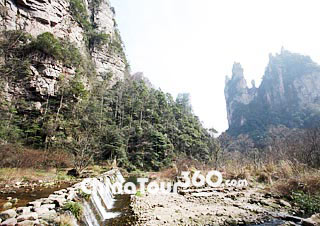 Phoenix Town, Zhangjiajie
Phoenix Town, Zhangjiajie Zhangjiajie Scenic Area
Zhangjiajie Scenic Area
Hunan, meaning 'south of the lake', was derived from the fact that the province is located south of the Dongting Lake, the second largest freshwater lake in China. Because of the Xiang River, which flows across the province from south to north, Hunan is also called 'Xiang' for short. Occupying an area of 210,000 square kilometers (81,081 square miles), Hunan has a population of 64.40 million by 2000, mainly including ethnic groups of Han, Tu, Miao, Hui, Dong, Yao, Uygur and Zhuang.
Hunan has a long history. According to archaeological finds and recorded history, there were human beings living in this area more than 8,000 years ago. Hunan Province was officially set up in 1664 during the Qing Dynasty (1644 - 1911). Its landscape is magnificent, and it is home to numerous men of great renown. It is the home province of Chairman Mao, founder of the People's Republic of China, and numerous other outstanding historical figures.
Situated in the south of the middle reaches of the Yangtze River, it borders Hubei in the north, Jiangxi to the east, Guangdong to the south, Guangxi to the southwest, Guizhou to the west, and Chongqing to the northwest. The east, south and west sides of the province are surrounded by mountains and hills, such as the Wuling Mountains to the northwest, the Xuefeng Mountains to the west, the Nanling Mountains to the south, and the Luoxiao Mountains to the east. The Xiangjiang, the Zijiang, the Yuanjiang and the Lishui Rivers converge on the Yangtze River at Lake Dongting in the north of Hunan.
Hunan has lots of elegant landscapes and numerous historic sites. It now has over 20,000 cultural remains and 43 scenic area covering Mount Hengshan, WulingYuan, Yueyang Tower, Dongting Lake and Shaoshan.
WulingYuan tourist area (including Zhangjiajie, Suoxi Valley, Tianzi Mountain and Mengdong River), with its unique physiognomy, limestone caves, brooks, hot springs, ancient trees and rare animals, has been placed by United Nations Educational, Scientific and Cultural Organization (UNESCO) on the World Natural Heritage List. Mount Hengshan is the famous sacred mountain of Buddhism and a summer resort. Yueyang Tower is also well known at home and abroad for its long history, folklore and grand architecture. Changsha, the provincial capital, is a historic and cultural city. Tourist sites there also include Han Dynasty Tombs at Mawangdui, Yuelu Hill, Loving Youth Pavilion (Aiwanting), Orange Isle (Juzizhou), and Yuelu Academy of Classical Learning.







